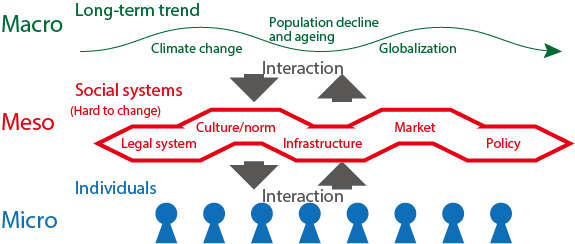About transition studies

I have been focusing on “transition” as a study of policy processes. In the Japanese language, it is sometimes translated as henkaku or ikou. Transition is a concept developed by researchers and practitioners mostly in Europe, especially in the Netherlands, and it begins with depicting society using a three-layer structure.

Figure: A conceptual diagram of the Multi-Level Perspective
Long-term trends (e.g., global warming, population decline, and aging population) are placed in the top layer, various social systems (e.g., legal systems, culture/norms, and infrastructure) are placed in the middle, and individuals are placed in the bottom layer. Individuals act by being constrained by social systems, and social systems cannot be sustainable unless they fit with long-term trends. On the other hand, individuals collaborate to improve social systems, and social systems may influence long-term trends.
If this “interaction” between these layers occurs continuously, a balanced society which is in equilibrium can be achieved.
In reality, however, because the social structures in the middle layer often resist change, a number of social problems emerge. For example, even if we know that it is necessary to deal with global warming (for example, the “decarbonization” of the Paris Agreement), our institutions that depend on fossil fuels, which have evolved since the time of the Industrial Revolution, are having difficulties in transforming themselves.
A “transition” is a change in a social structure that goes along with long-term trends. The focus of transition (management) research is the way in which societal transition can be accelerated in the right direction, especially in the context of global warming. In the past few years, I have also been conducting a few action research projects on transitions, such as ones for promoting bicycle usage and sustainable cities.
Nevertheless, societal structures do not change so quickly. There have been no visible transitions in my few years of practice. However, due to the current spread of COVID-19, we have experienced a few societal transitions in just a month or two.
Spread of COVID-19 and transition
1) COVID-19 as a trigger for a sudden, massive transition
In January 2020, news stories about local outbreaks in the People’s Republic of China began to appear. However, in Japan, it was quite difficult to imagine that an infectious disease would make such a huge impact on Japanese people. When I was on a recreational fishing boat in Yokohama in mid-February 2020 (caught 50 mackerels that day!) and saw the cruise ship Diamond Princess moored to Daikoku Pier, I felt like that the threat was at the opposite side of the sea. However, in late February 2020 the number of infected people in Japan started to rise, suddenly school closures were ordered out of the blue, and measures were rapidly expanded to implement an “80% reduction in human contact.” In a blink of an eye, the structure of our society changed.
This is a kind of transition. Both our economy, and our “normal” social lives, all suddenly changed drastically. If the spread of COVID-19 turns out to be entirely temporary, and our lifestyles are completely restored in 6 months or a year, then these changes may not represent a real transition. However, the spread of COVID-19 may have brought about permanent changes to our society, rather than just temporary effects.
2) Unexpected acceleration of work style reforms
For example, one change has been the introduction of so-called telework (remote work). Telework has been promoted in the last few years in order to release us from “commuting hell” and to enhance productivity, but most businesses have not adopted it. Various reasons have hindered the introduction of telework, such as the management of employees based on their physical attendance in the office and psychological discomfort with online communication. However, since the start of the COVID-19 pandemic almost all business entities in Tokyo have been forced to adopt telework because the typical Japanese cramped office environment and crowded commuter trains were identified as potential locations for cluster infections.
With the introduction of telework, the way we work has changed dramatically over the past year. If you’re at home, it’s a waste of time just to sit in front of a PC without doing anything. It’s better to do something else to improve your productivity. In addition, since it become impossible to make decisions that are formalized by using the traditional Japanese hanko stamp, the demand for electronic signature systems has rapidly increased. Furthermore, it seems that business meetings through video conferencing systems have become our new normal, and the ways in which meetings are moderated, and the conventional hierarchical relationships inside companies, are beginning to transform slowly.
Will these changes disappear when the COVID-19 pandemic subsides? For example, once a electronic signature mechanism has been adopted by a company, there is no need to return to the previous hanko-based system. Telework will probably be adopted by some companies for several days a week, or for the whole week. In the face of a recession, it is also expected that everyone’s awareness of productivity will rise significantly. I don’t have a time machine, so I can’t predict for sure about the future, but I suspect that our way of working in the post-COVID-19 world will be quite different from how it was before February 2020. In other words, a certain degree of irreversibility is embedded in the suddenly accelerated work style transition taking place.
3)The world after COVID-19
In addition to ways of working, it seems that some areas of public policy have experienced major transitions as a result of COVID-19. For example, in the medical field it is likely that the scope of visits by online doctors using smartphones will be significantly expanded. In the field of education, in addition to improving ICT infrastructures, legal instruments for using copyrighted materials in online lectures were implemented as an emergency measure, and furthermore, most teachers have come to overcome their discomfort of giving lectures online and have acquired ICT operation skills. Furthermore, the tourism and transportation industries will have to face major transitions in the near future. Of course, in some areas, it is hoped that these impacts will be temporary, and our “normal lives” will be restored. However, if you can identify the transitions that were suddenly accelerated by COVID-19, you should be able to envision a post-COVID-19 world and be prepared for it.
Conclusion
Although the COVID-19 pandemic has accelerated socio-technical transitions, it would have been definitely better for our society not to suffer from COVID-19 at all. There is no “good side” to COVID-19. Instead, governance study researchers must identify the governance mechanisms that can identify much-needed sustainable transitions and accelerate these transitions even during regular times. In addition to pandemic risks, our societies have to respond to many other kinds of long-term trends, such as climate change and population decline. As a researcher, I intend to continue exploring such governance mechanisms through a number of field experiments.
*The information contained herein is current as of May 2021.
* The contents of articles on Meiji.net are based on the personal ideas and opinions of the author and do not indicate the official opinion of Meiji University.
* I work to achieve SDGs related to the educational and research themes that I am currently engaged in.
Information noted in the articles and videos, such as positions and affiliations, are current at the time of production.


